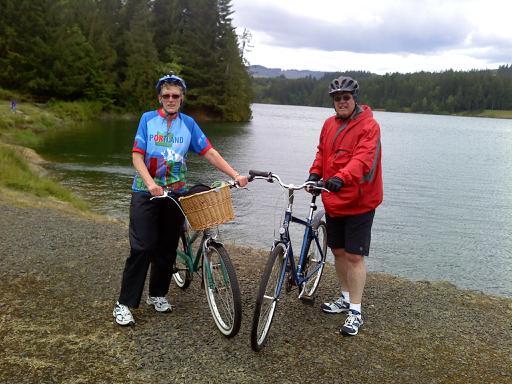FYI -- if the photos you are looking at seem small or cut off, just click on them to get them up to full size. I've noticed that sometimes you don't see the right half of each pic unless you do this.
We are now in Burgundy, on our way to the medieval town of Bourges. This morning we had a wonderful lesson in medieval castle-making at Guedelon. They have been in process since 1998 in building a castle according to genuine plans from Philip II drawn up in the 13th century and are using 13th century methods and materials. About 40 people are working on the project and they Re about half-way through. From quarrying and dressing the stone to smelting iron from the iron-rich sandstone, it's an authentic process. Although there are some government-required safety measures such as hard hats and steel-toed shoes, it could otherwise be a medieval worksite. It was initially funded by the government but is now self supporting through entrance fees for school groups and tourists. We found it fascinating. It gives one an appreciation for the labor involved in building the many churches, chalets and castles one sees throughout Europe. The entire project is done according to archeological evidence and written records, and the modern-day builders are also able to give feedback and flesh out details for the archeologists based on real-time experience.
 This wheel is powered by one person running like a hamster in a wheel and can raise a 400 pound load. This is how they move building materials up from the ground.
This wheel is powered by one person running like a hamster in a wheel and can raise a 400 pound load. This is how they move building materials up from the ground. This blacksmith is breaking iron-containing sandstone to get the iron bits out so that they can put them in a smelter to melt out the slag and produce iron. In two weeks they made only enough iron to make three nails because the sandstone here doesn't contain enough iron. They bring in iron from other sources. Easy to see why iron was a valuable commodity in the Middle Ages.
The blacksmith has made all the iron tools used on site in this forge.
They make the mortar here as well, from lime, sand and dirt. I was amazed to learn that mortar like this can take up to a HUNDRED years to dry completely in areas away from air.
Stone is quarried on site -- sandstone for the more durable, stronger portions like walls and limestone (which he is working now) for the more decorative areas.
These are the tools used to cut out the sandstone. It is so hard (because it is iron-containing sandstone) that they must use metal wedges and metal hammers placed over natural veins I. The rock in order to get it to split.
These are designs from medieval manuscripts painted on the limed interior walls. They make all the dyes there, as well as all the rope, tiles and pottery. They have two Belgian draft horses and two carts to transport heavy loads. The mortar is transported in baskets woven on site. Since the lime I the mortar is so corrosive, baskets are in need of constant repair or replacement.
We loved our tour of Guedelon and can't recommend it highly enough. We'd love to return in a year or so to see the progress. The employees figure it will take another 15 years to complete.
Aperitif -- kir
Entree: potato tarte
Eggs cooked in red wine with lardons (bacon bits)
Plat: coq au vin with tagliatelle
Fish cooked in red wine served with puréed mashed potatoes and celeriac
Pork cooked in red wine served with lentils
Cheese course: warm goat cheese served on toast
Dessert: creme brûlée with chestnuts
Prunes cooked in Armagnac
Pears cooked in red wine served with ice cream
Pear tart
Ice cream











No comments:
Post a Comment